雅思小作文 地图流程图
- 格式:ppt
- 大小:959.50 KB
- 文档页数:43

雅思小作文范文写作流程图流程图:1.这张图表展示出一个电冰箱是如何工作的____________________________________________________________ ___________________2.根据这个图表,在第一阶段,高压液体流进细管道。
冰箱中的食物放出蒸汽____________________________________________________________ ________________________________________________________________ _________________________________3.在这一阶段,高压液体被蒸汽加热成低压气体。
然后,低压温热气体向前运动至压缩机处____________________________________________________________ ________________________________________________________________ _________________________________4.在这一阶段,它被压缩成高压热气体____________________________________________________________ ___________________5.这个过程的第三个阶段是这些高压热气体通过冷凝器,在那它们被冷却成高压液体。
_____________________________________________________________________________________________________________________________________________________________6.那么,热到什么地方去了呢?此时,它们已经被转移到了大气当中。
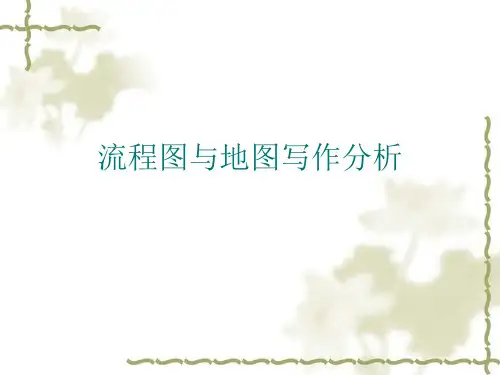

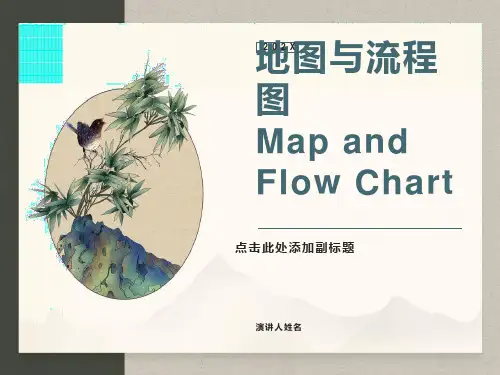

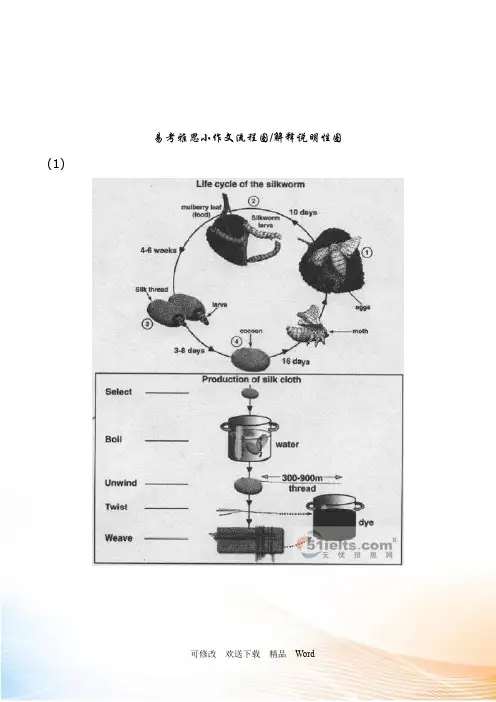
易考雅思小作文流程图/解释说明性图(1)(2)You should spend about 20 minutes on this task.The diagram below shows the method of obtaining water outdoors. You should write at least 150 words.(3)You should spend about 20 minutes on this task.The flow chart is about the National Yellow Stone Park in use after the fire disaster.You should write at least 150 words.(4)You should spend about 20 minutes on this task.The diagrams below show some principles of house design for cool and for warm climates.You should write at least 150 words.(5)You should spend about 20 minutes on this task.The government planned to build a supermarket in G Town. In the following map there are two alternative places for you to choose: place S1 and place S2. According to the information shown in the diagram, describe the benefits and drawbacks of the two locations.You should write at least 150 words.(6)You should spend about 20 minutes on this task.The diagram below shows the process of glass recycling. You should write at least 150 words.(7)You should spend about 20 minutes on this task.The diagram shows how organic waste is recycled to produce garden fertilizer. You should write at least 150 words.(8)You should spend about 20 minutes on this task.The diagram below shows the process by which bricks are manufactured for the building industry.Summarise the information by selecting and reporting the main features, and make comparisons where relevant.You should write at least 150 words.Brick manufacturing*Clay: type of sticky earth that is used for making bricks, pots, etc.(9)You should spend about 20 minutes on this task.The illustrations below show how chocolate is produced.Write at least 150 words.(10)1.?蚕丝制作?Sample:As is displayed in the first diagram, the life cycle of the silkworm can be categorized into 4 main stages. First, the life of the silkworm starts from eggs propagated by the moth, and it takes 10 days for each egg to become a silkworm larva that feeds on mulberry leaves. Silkworm larva continues to grow in 4 to 6 weeks, then wrapping itself with silk thread to construct a cocoon in the next 3 to 8 weeks. A moth can be produced from the cocoon in 16 days. The life cycle begins again from then on.Focusing on the second diagram, it illustrates the 5 main steps of the procedure of producing silk cloth. Well generated cocoons will be selected firstly. Before the silk thread can be unwound, cocoons have to be boiled in hot water. One cocoon can produce approximately 300 to 900 metres of silk thread. The unwound thread will be dyed afterwards to be weaved into silk cloth.Overall, the two diagrams reveal the stage of producing cocoons in the life cycle of the silkworm can be used to make silk cloth through 5 simple steps.Cambridge IELTS 6 Version:The first diagram shows that there are four main stages in the life of the silk worm.First of all, eggs are produced by the moth and it takes ten days for each egg to become a silkworm larva that feeds on mulberry leaves. This stage lasts for up to six weeks until the larva produces a cocoon of silk thread around itself. After a period of about three weeks, the adult moths eventually emerge from these cocoons and the life cycle begins again.The cocoons are the raw material used for the production of silk cloth. Once selected, they are boiled in water and the threads can be separated in the unwinding stage. Each thread is between 300 and 900 metres long, which means they can be twisted together, dyed and then used to produce cloth in the weaving stage.Overall, the diagrams show that the cocoon stage of the silkworm can be used to produce silk cloth through a very simple process.2. ?户外取水?The chart describes how water is obtained outdoors.According to the figure, the first step of obtaining water outdoors is to find a hole with green plants on its bottom. Next, remove the green plants in the middle and put a container there. Then, cover the hole with a plastic sheet and place two stones on both ends of it to secure its position. A third stone is laid on the middle of the plastic sheet so that the middle part is also the lowest part.When the sun shines on the green plants in the hole, waterevaporates from these plants. The vapor rises up and then cools down to form water drops on the plastic sheet. When there is more and more water, it flows along the sheet to accumulate on the lowest part. Finally, water falls down into the container directly under the middle stone.Thus, water is collected successfully through evaporation from green plants.3.?房屋不同季节的构造?As is displayed in the flow chart, the principles of insulation in cool and warm climate respectively differ to a large extent.As to the situation of cool climate, we adopt the high-angled roof in order to be nearly parallel with the direction of the sun so that the direct exposition to the heat of sun is lessened as much as we can. By this, the temperature of the material won’t fluctuate within a large range. Meanwhile, thermal building material could enhance the heat storage insulation, preventing outflow, thus reduction of heat.Adversely, in warm climate, reflective building material is indispensable with overhands for shade. The direction of the roof is almost vertical to the direction of the sun to lead to external insulation reflection. By this, ventilation would result in the removal of heat storage rather than reduction.Through the different working principles of ventilation, we are fascinated by the masterpieces of modern science and technology.4.?超市建造地点选择?As is unfolded in the map, Place M and N have their unique pros and cons as to the place for building the supermarket.First of all, Place N is located in the urban area of the G town, which may have more population and business. This advantage is incomparable with Place M. What’s more, Main road runs across the center area with convenience in traffic and logistics for the market afterwards. However, the place is equally far away from the neighborhood and the suburb area and cannot attract the residents in the outskirts.As a double-edged sword, Place M is more specifically customer-oriented. In spite of its comparably remote location with Place N, it would attract more customers in the outskirts, for they are reluctant to make a long trip for shopping. On the other hand, the train line nearby will also bring convenience in traffic to the urban-dwellers. Situated to the north-west of Place N, Place M is near the A and B Town with total population of 23 million, far outnumbering the overall population of D and E town, with 12 million.What’s worthy of being mentioned is that fierce competition in Place N and probable monopoly in Place M should also be taken into account when building the supermarket.5.?玻璃的再生?As is displayed in the flow chart, the recycling process of glass is really a complex one.The overall process can be categorized into 3 stages. First, glass products in various forms are gathered in the Collection point, so that they are easily transported by special trucks or vans to the Cleaning plant, where they get sterilization by high-pressured water. There are three different channels in the Recycling plant, namely Brown, Green and Clear, which represent the colors of glass. After recycled in the furnace, glass products are melted into recycled liquid glass. Mixed with new liquid glass, the compound is finally moulded into solid glass, which, afterwards, will be sent to various customer supermarkets for selling. Thus, the glass will go to the customers for different purposes.Through a brief introduction of the circle of glass recycling, we come to realize that recycling plays a vital role in environmental protection and ecological preservation.6.?化肥的制作?As is shown in the flow chart, the process of recycling organic waste to produce compost is really a complex one.The whole process can be categorized into five stages. First of all, prepare a plastic container which has four holes for ventilating the air. There is a rule when putting waste into the container, food at the bottom within 15 centimeters high, grass at the middle andnewspaper at the top within 15 centimeters high altogether, in order to make a optimum environment for different bacteria reproducing. In the following stage, we can witness nitrogen and water being put into the container. What's worth mentioning is that water is only added in a hot weather. Next, heat the waste and let the bacteria reproduce fastly, with which the organic waste can be decomposed and became garden fertiliser after 6 months. Subsequently, we can carry the compost out and move it to the garden, thus a new recycling can begin.In conclusion, using this way to turn the organic waste into garden fertiliser is environmentally friendly. By enlarging the number or volume of the container, we can dispose more waste at the same time.7.?美国黄石公园植被恢复?〔暂无范文〕8.?巧克力的制作?The diagram shows the stages in the process of making chocolate.Chocolate comes from the cacao tree, which is grown in parts of South America, Africa and Indonesia. The tree produces large red pods which contain white cocoa beans. Firstly, when the pods are ripe, they are harvested, the beans are removed and they are fermented for several days in large wooden boxes. During the fermenting process, the beans turn brown.Next, the brown beans are spread in the sun to dry. They are thenput in large sacks and transported by train or lorry. After this, the beans are taken to a chocolate factory where they are roasted in an oven at temperatures of between 250 and 350 degree Celsius.After being roasted, the beans are crushed and the outer shell is removed. This part is not needed for making chocolate. Finally, the inner part of the bean is pressed and liquid chocolate is produced.9. ?砖块的制作?The process by which bricks are manufactured for the building industry can be outlined in seven consecutive steps. First the raw material, clay, which was just below the surface of soil in certain clay-rich areas has to be dug up by a digger.Then the lumps of clay are placed on a metal grid in order to break up the big chunks of clay into much smaller areas, which fall through the metal grid onto a roller, whose motion further segregates the bits of clay. Sand and water are added to make a homogenous mixture, which is then either formed in moulds or cut into brick-shaped pieces by means of a wire cutter.Those fresh bricks are then kept in a drying oven for at least 24 and a maximum of 48 hours, several dozens if not hundreds of bricks at a time. The dried bricks are then transferred to a so-called kiln, another type of high temperature oven. First they are kept at a moderate temperature of 200 ℃-1300 ℃ . This process is followedby cooling down the finished bricks for 48 to 72 hours in a cooling chamber.Once the bricks have cooled down and have become hard, they get packaged and delivered to their final destination, be it a building site or storage.流程图的重点1)平实的格式As is displayed in the flow chart, the process/principle, etc of _____ can be explained/analyzed/specified as follows.There are ____stages in ______.First,Second,NextLast/Finally/In the end(Thus, the new circle begins.)As to/for, As far as …is concernedIn respect/aspect of, in approach to, in regard toConcerningOnThrough a brief introduction of ______, we come to realize how ______//the ___of ______.Having a glimpse of the general process of _____, we are fascinated/impressed by the ____ of _____//the fact that ________.2)句式的丰富多用被动语态2次多用定语从句2次多用状语从句1~2次多用分词短语2次多用介词短语2次3)过渡的自然4)准专业的词汇〔词汇量〕5)适当的展开加联想。
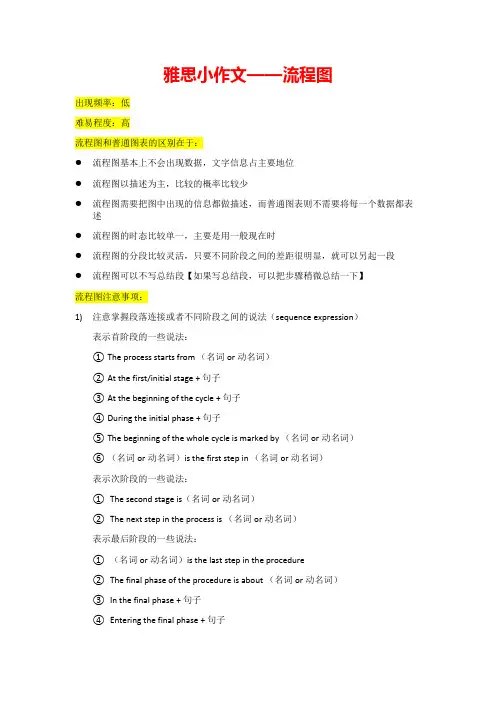
雅思小作文——流程图出现频率:低难易程度:高流程图和普通图表的区别在于:●流程图基本上不会出现数据,文字信息占主要地位●流程图以描述为主,比较的概率比较少●流程图需要把图中出现的信息都做描述,而普通图表则不需要将每一个数据都表述●流程图的时态比较单一,主要是用一般现在时●流程图的分段比较灵活,只要不同阶段之间的差距很明显,就可以另起一段●流程图可以不写总结段【如果写总结段,可以把步骤稍微总结一下】流程图注意事项:1)注意掌握段落连接或者不同阶段之间的说法(sequence expression)表示首阶段的一些说法:①The process starts from (名词or动名词)②At the first/initial stage + 句子③At the beginning of the cycle + 句子④During the initial phase + 句子⑤The beginning of the whole cycle is marked by (名词or动名词)⑥(名词or动名词)is the first step in (名词or动名词)表示次阶段的一些说法:①The second stage is(名词or动名词)②The next step in the process is (名词or动名词)表示最后阶段的一些说法:①(名词or动名词)is the last step in the procedure②The final phase of the procedure is about (名词or动名词)③In the final phase + 句子④Entering the final phase + 句子⑤(名词or动名词)is the final stage2)单词的转换主要体现在名词转换成动词。
流程图经常会出现一些器具的名词,如“grinder”“mixer”“heater”,考生需要改动成名词使用,如”ground”, “mixed”和”heated”例:The powders are delivered to the grinder, where they are ground into cement.3)注意流程图读图的顺序,很多是以循环形式出现4)除了连接词外,还可以使用分词结构和状语从句来表示顺序,如:下面几句话的意思是一样的,●Liquor butter is filtered, before being converted into solid butter.●Once liquor butter is filtered, it is converted into solid butter.●Liquor butter is filtered, until it is converted into solid matter.5)常用被动语态●误:Put these materials in the heater.●正:These materials are put in the heater.6)工序图的叙述流程图可以遵循下面的步骤:步骤1:确定材料步骤2:确定工具步骤3:确定动词,然后将这些信息写成一句话。
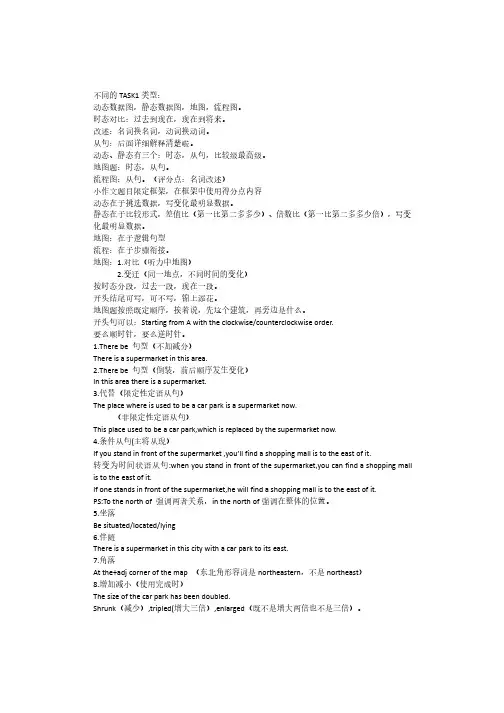
不同的TASK1类型:动态数据图,静态数据图,地图,流程图。
时态对比:过去到现在,现在到将来。
改述:名词换名词,动词换动词。
从句:后面详细解释清楚啦。
动态、静态有三个:时态,从句,比较级最高级。
地图题:时态,从句。
流程图:从句。
(评分点:名词改述)小作文题目限定框架,在框架中使用得分点内容动态在于挑选数据,写变化最明显数据。
静态在于比较形式,差值比(第一比第二多多少)、倍数比(第一比第二多多少倍),写变化最明显数据。
地图:在于逻辑句型流程:在于步骤衔接。
地图:1.对比(听力中地图)2.变迁(同一地点,不同时间的变化)按时态分段,过去一段,现在一段。
开头结尾可写,可不写,锦上添花。
地图题按照既定顺序,挨着说,先这个建筑,再旁边是什么。
开头句可以:Starting from A with the clockwise/counterclockwise order.要么顺时针,要么逆时针。
1.There be句型(不加减分)There is a supermarket in this area.2.There be句型(倒装,前后顺序发生变化)In this area there is a supermarket.3.代替(限定性定语从句)The place where is used to be a car park is a supermarket now.(非限定性定语从句)This place used to be a car park,which is replaced by the supermarket now.4.条件从句(主将从现)If you stand in front of the supermarket,you’ll find a shopping mall is to the east of it.转变为时间状语从句:when you stand in front of the supermarket,you can find a shopping mall is to the east of it.If one stands in front of the supermarket,he will find a shopping mall is to the east of it.PS:To the north of强调两者关系,in the north of强调在整体的位置。
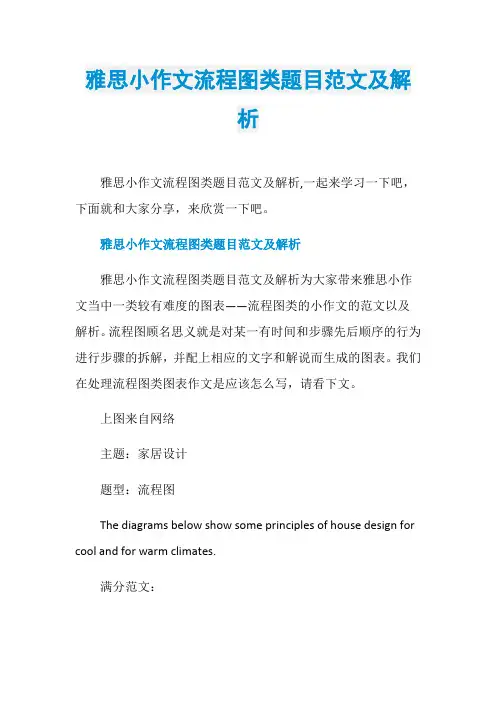
雅思小作文流程图类题目范文及解析雅思小作文流程图类题目范文及解析,一起来学习一下吧,下面就和大家分享,来欣赏一下吧。
雅思小作文流程图类题目范文及解析雅思小作文流程图类题目范文及解析为大家带来雅思小作文当中一类较有难度的图表——流程图类的小作文的范文以及解析。
流程图顾名思义就是对某一有时间和步骤先后顺序的行为进行步骤的拆解,并配上相应的文字和解说而生成的图表。
我们在处理流程图类图表作文是应该怎么写,请看下文。
上图来自网络主题:家居设计题型:流程图The diagrams below show some principles of house design for cool and for warm climates.满分范文:The diagrams show how house designs differ according to climate.这些图表显示房子的设计因气候而不同。
The most noticeable difference between houses designed for cool and warm climates is in the shape of the roof. The designs also differ with regard to the windows and the use of insulation.为凉爽和温暖气候设计的房子之间最明显的区别是屋顶的形状。
在窗户和保温材料的使用方面,设计也有所不同。
We can see that the cool climate house has a high-angled roof, which allows sunlight to enter through the window. By contrast, the roof of the warm climate house has a peak in the middle and roof overhangs to shade the windows. Insulation and thermal building materials are used in cool climates to reduce heat loss, whereas insulation and reflective materials are used to keep the heat out in warm climates.我们可以看到凉爽的气候房子有一个高角度的屋顶,它允许阳光通过窗户进入。
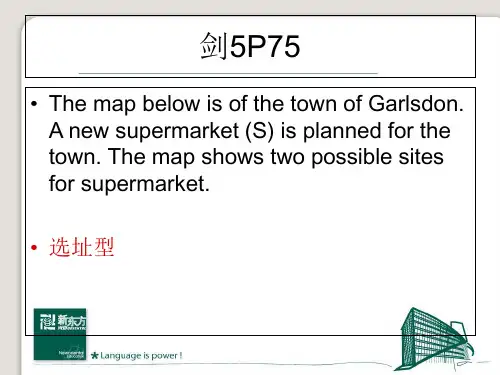
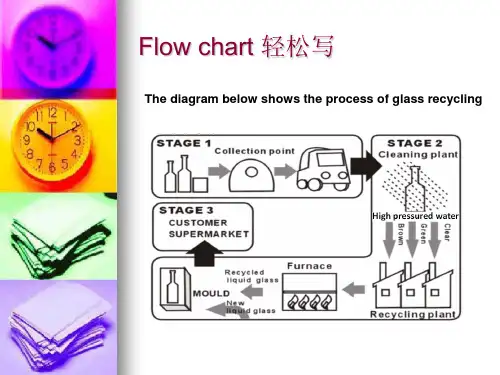
解析雅思作文里面的流程图一、识别流程图在烤鸭们准备雅思写作的过程中,很少的学生会注意到图形的辨别对于成功写作的重要性,因为他们更多的注意句子的背诵亦或是模版的准备。
其实这样的复习方式有点欠妥,因为不同类型的流程图可能在个别内容的处理上会有所区别。
拿下面两个流程图举个例子:图片(一)是一个含有整个循环周期内容的流程图,而图片(二)是关于某个生产过程为下个过程提供原材料的图形。
图片(一)图片(二)二、识别图形的重要性:这两个图形在书写过程中是有点小区别的:可以明显的看出在开头段落书写是有点区别的,尤其是在body2段末的地方在图片(一)的时候要提到新的周期就要开始了,而图片(二)只要描述完这个段落的过程在段末不需要说什么语言的。
可见在烤鸭们备考流程图的过程中要将自己复习的这个素材按照类别归类好,在细节上处理好,就可以为赢得高分起到重要作用。
三、流程图的段落结构及其句型确定好了流程图形的区别后,段落的划分和句子的书写就提到议事日程上了。
A. 段落的划分:就以上这两个类别的图形而言,图片(二)就很明显了:生产原材料的段落就是主体段落一,其次就是主体段落二。
但是图片(一)就得根据实际生活的原理和段落见得平衡考虑就是:主体段落一:从瓶子的搜集到它的清洗完毕准备送走;主体段落二:锻造到包装塑形;主体段落三:送到消费者手里到一轮新的周期的再次轮回。
B. 流程图句型包含什么元素?其实书写流程图最大的难度是怎样避免写成流水账,而丰富的句型就可以避免这个问题,XX沃的雅思托福培训中心的老师在长期的教学中总结了以下句型。
为了让烤鸭们有个很好的了解,列举的大多数句型是针对同一个意思的句子的多种表达方式:•After fine clay is available on the roller, it is mixed/bined with sand and water. •Do not bine sand and water until fine clay is obtained.•No sooner is the fine clay obtained than it is bined with sand and water.•Clay excavated by the digger is put on the metal grid, through which clay containing rocks and stones are filtered.•T o leave extra oil behind, the fried banana chips are placed on a special grid before the cooling procedure.•The following/ next/ subsequent/ stage/ phase/ process/ step is to do /doing/ that...•__......... to leave silt behind•__......... purifying the clay•__......... that clay is needed to be filtered四、什么样的语法现象比较常见为了让烤鸭们对于上述教学中常用的句子有更深入的理解,我把图片(一)的一个流程图片段书写之后的内容呈现给鸭鸭们以进一步解释语法现象:(2)Prior to the entire process, preparation with great care is great necessity,(1) involving collection and cleaning. T o be specific, (2)Once used bottles (3)are discarded by the customers into the dustbins, they are delivered to the cleaning plant with a van.(4)In order to ensure the bottles clean, high-pressurized water(3)is employed to rinse these collected bottles. Classification is anotherimportant phase, (5)which sorts/ categories the bottles by color--- green brown and clear for the further process.从上面的标号可以看出,以下几种是常见的语法现象:1. 分词伴随状语2. 时间状语从句3. 被动句式4.不定式短语作状语5.非限制性定语从句6. 动名词短语作句子主语或表语如果烤鸭们觉得仅仅从一个段落就能得出结论的话,那么再看中心老师写的段落二和三:段落二:(2) Once the procedure is pleted, concrete reusing procedure can be observed, involving broken pieces, forging, molding and delivery.(2)No sooner are the used bottles rinsed than they are sent to the glass factory,(5) in which they are ground into pieces. The following phase is that these pieces (3) are exposed to extreme heat in a special containment known as furnace. It is worth mentioning that (6)introducing some glass substances into the mold are needed with the purpose of their formation段落三:The final process is filling or packing(2) before these new bottles(3) are transported to venues they are needed. (2)After this phase is pleted, a new circle is ready.烤鸭们,你们能否以上从三个主体段落的编号能否看到常用的语法了?五、如何避免句子的单调现象很多的烤鸭们可能有这样的感受:看了老师写的流程图的文章给人的感觉不像自己所写的那样流水账,不能吸引人,怎样练就一手不是千篇一律的句子出来,达到句子的多样性呢?A. 方法一:写文章前多练习单句的表达方式,注意一下我在前面呈现的句子。
1. The process of brick manufacturing.注意:1. 介绍过程要使用一般现在时2. 使用定语从句将有关联的两句话连接。
3. 大量使用被动语态。
4. 使用一些表示顺序的连接词。
5. 一般不需要写总结。
The flow chart illustrates the production process of bricks usually used in building industry. Generally, seven stages are included, from material exploitation to delivery.Firstly, underground clay is dug up as the raw material by a large digger. Clay lumps are then stacked on a metal grid which serves to break up chunks into much smaller pieces. After falling on a roller, the stuff is further conveyed and mixed with sand and water.In following stage, the well-blended compound is pressed in a mould or cut by a wire cutter, in order to form brick-shaped pieces. During next 24-48 hours, dozens of these fresh bricks are kept in a room, namely drying oven.Once the bricks are dry, the next stage is heating and cooling process. bricks are transferred in a so-called kiln, another type of hotter oven, in which they are burned twice, moderately and highly, in temperature from 200°C-980°C to about 870°C-1300°C. This is followed by depositing heated bricks in a cooling chamber for 2 or 3 days.Finally, cooled hard bricks get packed and delivered by trucks to their destination, a building site.(194)2. The production of steam using a gas cooled nuclear reactor.1. 看懂基本过程和原理,定位流程的起点和终点。